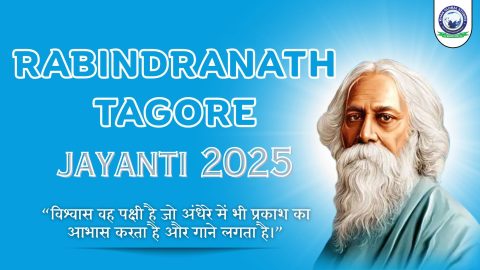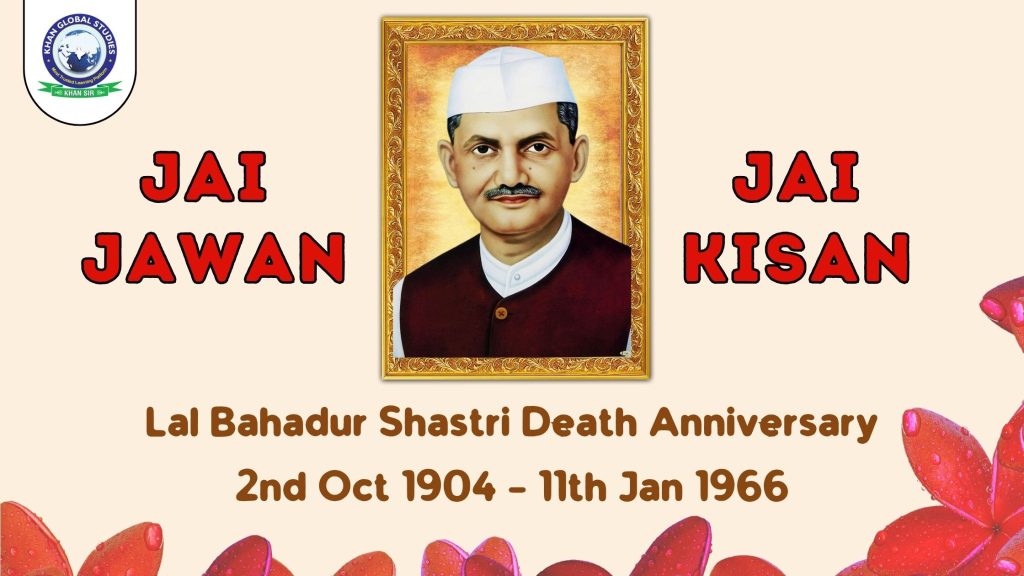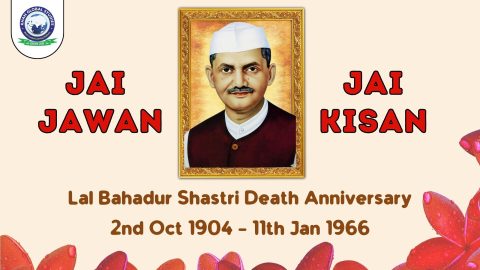Lal Bahadur Shastri was the second Prime Minister of India and a prominent leader of the Indian freedom struggle. He is remembered for his simplicity, honesty, and patriotism. He gave the nation the slogan “Jai Jawan, Jai Kisan” (Hail the Soldier, Hail the Farmer), which continues to resonate in the hearts of every Indian. His life is a symbol of struggle and inspiration.
Early Life and Education
Lal Bahadur Shastri was born on October 2, 1904, in Mughalsarai, Uttar Pradesh. His father, Sharda Prasad Srivastava, was a school teacher, and his mother, Ramdulari Devi, was a homemaker. Tragically, Shastri lost his father at a young age, and his mother raised him under challenging circumstances.
Shastri’s original name was Lal Bahadur Srivastava. The title “Shastri” was conferred upon him after he completed his education in Sanatan Dharma from Kashi Vidyapith in Varanasi. From a young age, he opposed social inequalities and decided to drop his caste-based surname, “Srivastava.”
Contribution to the Freedom Struggle
Lal Bahadur Shastri became an active participant in the freedom struggle under the leadership of Mahatma Gandhi. In 1920, he joined the Non-Cooperation Movement. Later, he actively participated in the Dandi March of 1930 and the Quit India Movement of 1942. Despite facing imprisonment several times, he never compromised on his commitment to the cause.
After India gained independence, Shastri worked closely with Jawaharlal Nehru in building the nation. He rose to prominence within the Indian National Congress and played a key role in shaping independent India’s policies and progress.
Contribution as Prime Minister
Lal Bahadur Shastri assumed the office of the second Prime Minister of India on May 27, 1964, following the death of Jawaharlal Nehru. Although his tenure lasted only 19 months, it was a crucial period in Indian politics.
- “Jai Jawan, Jai Kisan” Slogan: During the 1965 India-Pakistan War, Shastri gave the famous slogan “Jai Jawan, Jai Kisan” (Hail the Soldier, Hail the Farmer), which was meant to boost the morale of the Indian army and farmers alike.
- Green Revolution: Shastri promoted the Green Revolution in the agricultural sector, encouraging the use of modern farming techniques and high-yielding crop varieties. This initiative made India self-sufficient in food grain production and helped alleviate food shortages.
- 1965 War with Pakistan: During the 1965 war with Pakistan, Shastri’s leadership proved pivotal in ensuring India’s victory. His resolve and determination earned him the admiration of the nation, and he became a beloved leader.
- Simplicity and Integrity: Known for his simple lifestyle and ethical values, Shastri lived modestly even as Prime Minister. His integrity and dedication to public service made him a symbol of honesty and humility.
Death and Death Anniversary
Lal Bahadur Shastri passed away on January 11, 1966, in Tashkent, Uzbekistan (then part of the Soviet Union). He had traveled to Tashkent to sign a peace agreement (the Tashkent Agreement) with Pakistan following the 1965 war. His sudden death raised many questions and remains a subject of debate to this day.
Cause of Death
The Indian Army bravely confronted Pakistan’s aggression during the 1965 India-Pakistan War and launched an attack on Lahore. This unexpected action caused concern in the United States, which demanded a ceasefire and the safe evacuation of its citizens from Lahore. Due to diplomatic pressure from both the Soviet Union and the United States, Prime Minister Lal Bahadur Shastri was summoned to Tashkent for peace talks.
In the Tashkent Agreement, Shastri accepted all the terms but opposed the return of Indian territories occupied by Pakistan. Despite international pressure, he had to sign the agreement, but as Prime Minister, he firmly refused to give up these regions.
On the night of January 11, 1966, just hours after signing the ceasefire agreement with Pakistan’s President Ayub Khan, Shastri suddenly and mysteriously passed away. Officially, his death was attributed to a heart attack. His cremation was held with full state honors at ShantiVan, near the Yamuna River, which was later renamed Vijay Ghat. Following Shastri’s death, until the Congress Party chose Indira Gandhi as his successor, Gulzarilal Nanda served as the acting Prime Minister.
Controversy Surrounding His Death
There have been numerous questions regarding Shastri’s sudden death. His family, along with many others, believes that his death was not due to a heart attack but possibly caused by poisoning. The initial inquiry was conducted by Raj Narayan, but it did not reach any conclusions. Surprisingly, there is no record of this investigation available in the Indian Parliamentary Library. Additionally, there are allegations that Shastri did not undergo an autopsy.
In 2009, when this issue was raised again, the government revealed that Shastri’s private doctor, Dr. R.N. Chugh, along with some Russian doctors, had conducted an investigation. However, no official record of this examination was found.
In 2009, the book “CIA’s Eye on South Asia” by Anuj Dhar highlighted the government’s decision not to release documents related to Shastri’s death. The government stated that making these documents public could harm India’s international relations and create instability within the country.
The tragic story of Shastri’s death was first revealed in the 1978 Hindi book “Lalita Ke Ansoo”, written by his wife Lalita Shastri. Journalist Kuldeep Nayar and Shastri’s son Sunil Shastri also demanded that the truth behind this mystery be uncovered. The book “Mitrokhon Archive” offers in-depth insights into the Tashkent Agreement and the political circumstances of the time.
Importance of His Death Anniversary
Every year, on January 11, the nation pays tribute to Lal Bahadur Shastri on his death anniversary. On this day, the country remembers his simplicity, determination, and dedication to service. Shastri’s life is an epitome of patriotism and sacrifice.
Inspiration from Lal Bahadur Shastri
Lal Bahadur Shastri’s life is an inspiration for every Indian. The values and principles he upheld are still relevant today. His life conveys the message that with simplicity and hard work, one can achieve their goals.
Lessons from His Life
- Patriotism and Selfless Service: He always prioritized the nation’s interest over personal gain.
- Simplicity: His life shows that greatness lies in simplicity.
- Determination: Even in difficult circumstances, his confidence remained unwavering.
Conclusion
Lal Bahadur Shastri was a shining star in Indian politics who made a significant impact during his brief tenure. His death anniversary reminds us to reflect on his ideals and follow the path he laid for the nation. His simplicity, loyalty, and hard work will always remain a source of inspiration for all Indians.
His slogan “Jai Jawan, Jai Kisan” still ignites a sense of passion in the hearts of every Indian today.




